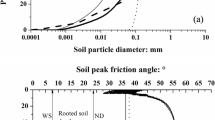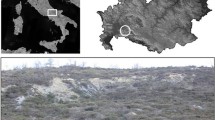Abstract
Trees bend and break when exposed to external forces such as wind, rockfall, and avalanches. A common simplification when modelling the tree response to these forces is to simplify the system as a clamped beam which means that the stem deflection is related to the stem flexibility only. However, a certain part of the stem deflection originates from rotation of the root-soil plate. In this paper, we investigate this contribution to the overall stem deflection. Norway spruce (Picea abies (L.) Karst) trees were subjected to winching tests to analyse the anchorage mechanics of the tree. The tests were performed at two experimental sites with an average slope of 32 and 34° and one site with a nearly flat ground in subalpine forests near Davos, Switzerland, during the vegetation periods of 2003 and 2004. The trees were pulled downslope with a winch and the applied force, stem base rotation, and the angle of the applied force relative to the stem were recorded. After the tree had fallen over, stem diameter and branch mass were measured for every meter segment. These data were used to model the tree in the finite element software ANSYS®, which was used for calculating the rotational stem base moment as a␣function of stem base rotation. The root-soil rotation stiffness k root was defined as the secant stiffness calculated at 0.5° root-soil plate rotation. Young’s modulus of elasticity E of the stem was iteratively changed until the correct stem rotation was obtained. The best correlation between k root and different tree characteristics was the squared diameter at breast height, DBH2. Not incorporating the normal forces due to weight of the overhanging masses from crown and stem resulted in a maximum underestimation for k root of approximately 14%. Thus, also the acting moment on the stem base will be underestimated causing the safety factor against uprooting to be overestimated.
Similar content being viewed by others
Abbreviations
- k root :
-
root-soil rotation stiffness (kN m/rad)
- E :
-
Young’s modulus of elasticity (MPa)
- DBH:
-
diameter at breast height (m)
- H t :
-
total tree height (m)
- H f :
-
height of applied force (m)
- H c :
-
crown length (m)
- W t :
-
total tree mass (kg)
- W c :
-
crown mass (kg)
- F :
-
applied force (kN)
- F h :
-
horizontal force component (kN)
- F v :
-
vertical force component (kN)
- βF :
-
measured angle of the applied force in relation to the horizontal plane (°)
- ρ:
-
density of green wood (kg/m3)
- M :
-
rotational stem base moment (Nm)
- θ0 :
-
extrapolated stem base rotation due to initial leaning of stem (°)
- P :
-
level of significance for the polynomial coefficients
References
Achim A, Nicoll B, Mochan S, Gardiner B (2003) Wind stability of trees on slopes. In: Ruck B, Kottmeier C, Mattheck C, Quine C, Wilhelm G (eds) International conference wind effects on trees. Laboratory for Building- and Environmental Aerodynamics, Inst. for Hydromechanics, University of Karlsruhe, Germany, pp 231–237
Ammann M (2005) Abgestorbene Bäume: Mechanische Eigenschaften und Schutzwirkung gegen Naturgefahren. Holzforschung Schweiz 1:4–5
ANSYS (2002) ANSYS, Inc. theory reference, verison 7.0, Canonsburg, USA
Blackwell PG, Rennolls K, Coutts MP (1990) A root anchorage model for shallowly rooted Sitka Spruce. Forestry 63:73–91
Bolkenius D (2001) Zur Wurtzelausbildung von Fichte (Picea abies L. [Karst] und weiβbanne (Abies alba Mill.) in gleich- und ungleichhaltrigen Bestände. Berichte Freiburger Forstliche Forschung Heft, p 35
Brassel P, Brändli UB (1999) Schweizerisches Landesforstinventar. Ergebnisse der Zweitaufnahme 1993–1995. Paul Haupt, Bern Stuttgart Wien, pp 442
Brüchert F, Becker G, Speck T (2000) The mechanics of Norway spruce [Picea abies (L.) Karst]: mechanical properties of standing trees from different thinning regimes. Forest Ecol Manag 135:45–62
Brudi E, Wassenaer PV (2001) Trees and statics: nondestructive failure analysis. In: Thomas ES, Kim DK (eds) Tree structure and mechanics conference proceedings: how trees stand up and fall down. International Soc. of Arboriculture, pp 53–69
Coutts MP (1983) Root architecture and tree stability. Plant Soil 71:171–188
Coutts MP (1986) Components of tree stability in Sitka Spruce on peaty gley soil. Forestry 59:173–197
Crook MJ, Ennos AR (1996) The anchorage mechanics of deep rooted larch, Larix europea x L. japonica. J Exp Bot 47:1509–1517
Ellenberg H (1996) Vegetation Mitteleuropas mit den Alpen in ökologischer, dynamischer und historischer Sicht. Ulmer, Stuttgart, pp 1093
Fraser AI, Gardiner JBH (1967) Rooting and stability in Sitka Spruce. For Commission Bull 40:1–28
Gardiner BA, Peltola H, Kellomäki S (2000) Comparison of two models for predicting the critical wind speeds required to damage coniferous trees. Ecol Model 129:1–23
Kollman FPP, Côté WA (1968) Principles of wood science and technology. I, Solid wood. Springer-Verlag, pp 502
Meteoschweiz (2004) Messstation Davos. http://www.meteoschweiz.ch/- de/Klima/Klimapublikationen/IndexKlimapublikationen.shtml.
Milne R (1991) Dynamics of swaying of Picea sitchensis. Tree Physiol 9:383–399
Milne R, Blackburn P (1989) The elasticity and vertical distribution of stress within stems of Picea sitchensis. Tree Physiol 5:195–205
Moore JR (2000) Differences in maximum resistive bending moments of Pinus radiata trees grown on a range of soil types. Forest Ecol Manag 135:63–71
Neild SA, Wood CJ (1999) Estimating stem and root-anchorage flexibility in trees. Tree Physiol 19:141–151
Nicoll BC, Achim A, Mochen S, Gardiner BA (2005) Does steep terrain influence tree stability? A field investigation. Can J For Res 35:2360–2367
Peltola H, Kellomäki S, Väisänen H, PIV (1999) A mechanistic model for assessing the risk of wind and snow damage to single trees and stands of Scots pine, Norway Spruce and Birch. Can J For Res 29:647–661
Peltola H, Kellomäki S, Hassinen A, Granander M (2000) Mechanical stability of Scots pine, Norway spruce and Birch: an analysis of tree-pulling experiments in Finland. Forest Ecol Manag 135:143–153
Saunderson SET, England AH, Baker CJ (1999) A dynamic model of the behaviour of Sitka Spruce in high winds. J Theor Biol 200:249–259
Stokes A, Berthier S, Nadhezdhina NJC, Loustau D (2000) Sap flow in trees is influenced by stem movement. In: Spatz HZ, Speck T (eds) Plant biomechanics 2000: proceedings of the 3rd plant biomechanics conference freiburg-badenweiler, 27 August–2 September, 2000. Stuttgart, Thieme, pp 272–277
Yang YB, Yang YT, Su HH (2004) Behavior of the tree branches, trunk, and root anchorage by nonlinear finite element analysis. Adv Struct Eng 7:1–14
Acknowledgements
This study was supported by the Board of the Swiss Federal Institutes of Technology. We thank the landowners of the experimental sites for allowing us to perform the experiments, “Forstwerkhof Davos” for providing useful help during the fieldwork, Holger Simon for conducting the field experiments, Prof. Dr. Alessandro Dazio (Institut für Baustatik und Konstruktion ETH-Zurich) and the anonymous reviewers of this paper.
Author information
Authors and Affiliations
Corresponding author
Rights and permissions
About this article
Cite this article
Jonsson, M.J., Foetzki, A., Kalberer, M. et al. Root-soil rotation stiffness of Norway spruce (Picea abies (L.) Karst) growing on subalpine forested slopes. Plant Soil 285, 267–277 (2006). https://doi.org/10.1007/s11104-006-9013-7
Received:
Accepted:
Published:
Issue Date:
DOI: https://doi.org/10.1007/s11104-006-9013-7




